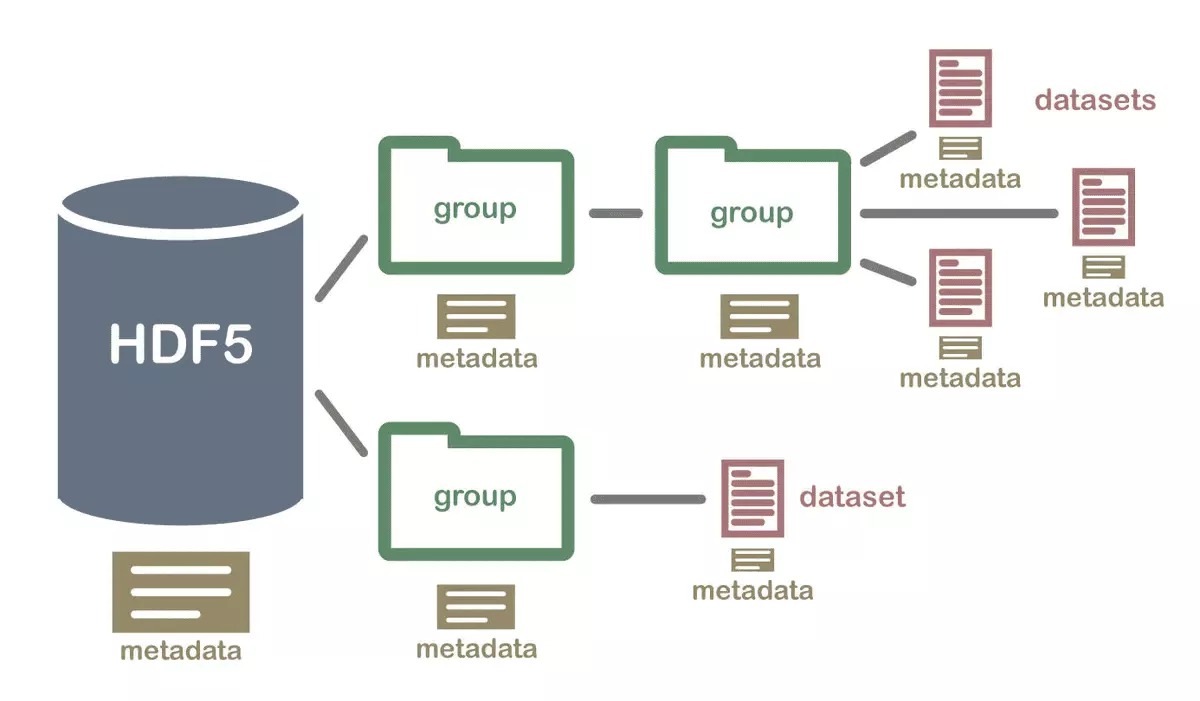R语言rhdf5读写hdf5并展示文件组织结构和索引数据
前言
h5只是一种简单的数据组织格式【层级数据存储格式(HierarchicalDataFormat:HDF)】,该格式被设计用以存储和组织大量数据。

在一些单细胞文献中,作者通常会将分析的数据上传到GEO数据库保存为.h5格式文件,而不是我们常见的工程文件(rds文件,表格数据等),所以为了解析利用这些数据需要对hdf5格式的组织结构有一定的了解。
(注:在Seurat包中有现成的函数Seurat::Read10X_h5()可以用来提取表达矩阵,但似乎此外无法从h5文件中提取更多的信息)。

在R语言中对HDF5进行操作的软件包为rhdf5。
install.packages("BiocManager");BiocManager::install("rhdf5");library(rhdf5)
打开.h5文件 和 展示内容的组织结构
h5_file= H5Fopen("new.h5")
####如下所示,new.h5文件内创建了一个组(group1_mat)
#组内又创建了df和matrix两个层级用以保存矩阵和数据框
> h5dump(h5_file,load=FALSE)
$group1_mat
$group1_mat$df
group name otype dclass dim
1 / df H5I_DATASET COMPOUND 5
$group1_mat$matrix
group name otype dclass dim
1 / matrix H5I_DATASET FLOAT 3 x 2
数据索引通过“$”符进行
> h5_file$group1_mat$df
C_1 C_2 C_3 name
1 3 5 69 xx
2 2 8 60 yy
3 8 4 92 gg
4 1 6 16 ll
5 7 4 25 mm
关闭hdf5文件
H5Fclose(h5_file)#关闭当前打开的hdf5文件
h5closeAll()#关闭所有打开的hdf5文件
构建自己的hdf5文件
###准备数据
mdat <- matrix(c(0,2,3, 11,12,13), nrow = 2, ncol = 3, byrow = TRUE,dimnames = list(c("row1", "row2"),c("C.1", "C.2", "C.3")))
df <- data.frame(C_1 = c(3,2,8,1,7),C_2 = c(5,8,4,6,4),C_3 = round(runif(n = 5), 2) * 100,name = c("xx","yy","gg",'ll','mm'))
mdat.spar <- Matrix::Matrix(mdat, sparse = TRUE)
my_array <- array(seq(0.1,2.0,by=0.1),dim=c(5,2,2))
my_list <- list(my_array[,,1],my_array[,,2])
my_string <- "This is one hdf structure file"
###构建.h5文件
h5createFile("new.h5")
# Saving matrix information.
h5createGroup("new.h5","group1_mat")
h5write(mdat, "new.h5", "group1_mat/matrix")
h5write(df, "new.h5", "group1_mat/df")
# Saving sparse_matrix information.
mdat.spar <- as(mdat, "dgCMatrix")
h5createGroup("new.h5","group2_sparseMTX")
h5write(mdat.spar@x, "new.h5", "group2_sparseMTX/data")
h5write(dim(mdat.spar), "new.h5", "group2_sparseMTX/shape")
h5write(mdat.spar@i, "new.h5", "group2_sparseMTX/indices") # already zero-indexed.
h5write(mdat.spar@p, "new.h5", "group2_sparseMTX/indptr")
# Saving array and list data
h5createGroup("new.h5","group3_aL")
h5write(my_list, "new.h5", "group3_aL/list")
h5write(my_array, "new.h5", "group3_aL/array")
# Saving string data
h5createGroup("new.h5","group4_string")
h5write(my_string, "new.h5", "group4_string/string")
h5closeAll()
参考官方说明 rhdf5 - HDF5 interface for R (bioconductor.org)
以上就是R语言rhdf5读写hdf5并展示文件组织结构和索引数据的详细内容,更多关于R语言rhdf5读写hdf5的资料请关注软件开发网其它相关文章!
相关文章
Nyako
2021-06-03
Jacuqeline
2020-10-05
An
2021-07-09
Psyche
2023-07-20
Winola
2023-07-20
Gella
2023-07-20
Grizelda
2023-07-20
Janna
2023-07-20
Ophelia
2023-07-21
Crystal
2023-07-21
Laila
2023-07-21
Aine
2023-07-21
Bliss
2023-07-21
Lillian
2023-07-21
Tertia
2023-07-21
Olive
2023-07-21
Zahara
2023-07-21
Angie
2023-07-21
Nora
2023-07-24